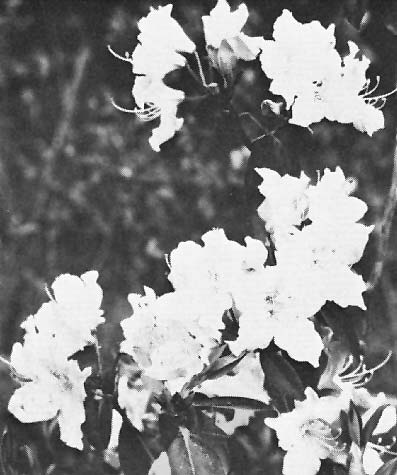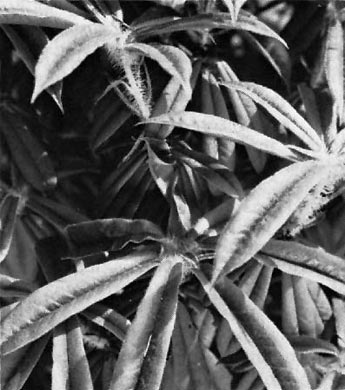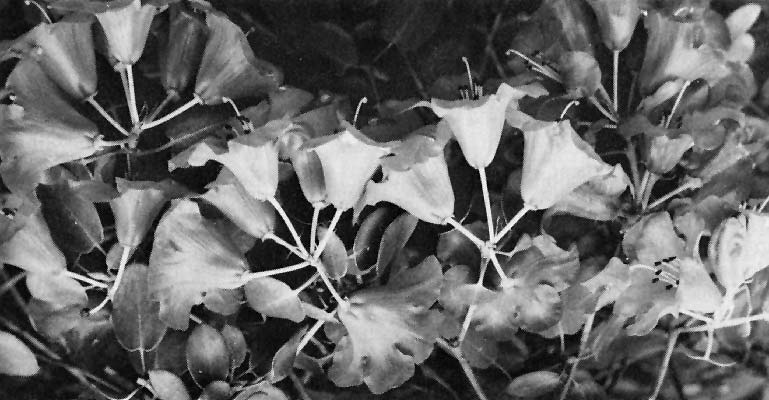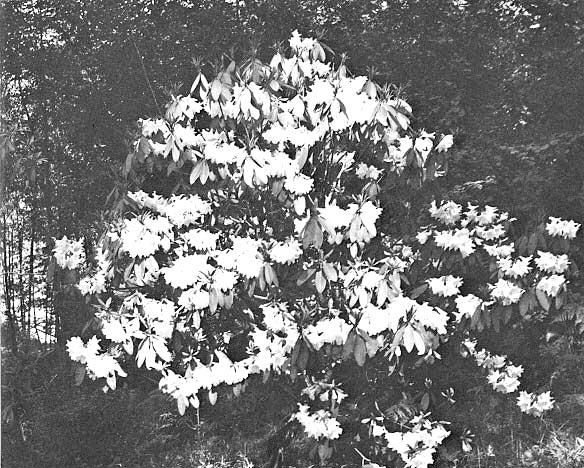E. H. "Chinese" Wilson, Plant Hunter
Gwen Bell, Seattle, Washington
"China, the Mother of Gardens" was for many years the home of E. H. Wilson. During the first eleven years of the 20th Century, he spent most of his time traveling about China. In 1914 Wilson made a trip to Japan for the Arnold Arboretum and in 1917 explored Korea, its adjacent islands and Formosa. When he returned to Arnold Arboretum in 1919, the Director, Professor Sargent appointed him Assistant Director. Professor Sargent was interested in making contacts with other botanical gardens, so he sent Wilson on a global tour to broaden their horticultural knowledge. However his greatest pleasure was in the time he had spent in China.
Wilson was noted for instinctively knowing what gardeners would like, realizing their great desire for the exotics, and being able to assess the landscape value of plants. He was responsible for several hundred plants being introduced to England and America by way of herbarium specimens and seeds of 1500 different species. He traveled several thousand miles throughout the interior of China.
Gloucestershire was the birthplace of this young English boy; born February 15, 1876. He had a great love of plants as a small boy. His ambition was to be a botany teacher and he wished to attend the Royal College of Science. Being the oldest of seven children, he felt, after the death of his father, an obligation to help his mother, so he took a job with the Birmingham Botanical Gardens. He also studied botany at the Birmingham Technical School. He was a good student and was awarded the Queen's prize. The Director of Kew Gardens recommended young Wilson to Veitch and Sons, leading English Nurserymen, as a potential explorer. They were seeking the rare
Davidia involucrata
(Dove tree) native to interior China, which had been discovered and described by Pere Armand David.
With this recommendation from Kew and his knowledge of botany, Wilson was sent by Veitch to their Coombe Wood Nursery to be trained by George Harrow. Harrow was a nurseryman of great skill and he passed on his skill and knowledge of the exotic woody plants of China's flora to Wilson.
Plant hunting requires certain qualifications. Wilson summed it up when he wrote: "It takes a sound constitution, plenty of enthusiasm, patience, tact, and an abundance of time. A great deal of patience is required to put up with the delays and slipshod ways of the native people, as the Chinese do not see time from the point of view of the Westerner". He was also told that he could lose his life and his body might never be found. He experienced every kind of frustration, withstood the rigors of poor housing, primitive methods of travel and language problems. He found everything to be as he had been told. However, he earned the name "Chinese Wilson" because of his ability to cope and to get along with the Chinese people. He was young and adaptable, only 22 years old.
The governing officials in China were insolent in their dealings with all outsiders, considering them as inferiors. Europeans were looked upon as "Western Devils who couldn't be trusted". This notion prevailed until the end of the 19th century. Prior to this almost all plant collecting was done within 30 miles of the coast and much of what was collected during the 19th century came from private gardens.
For one thing, Europeans were tall by Oriental standards and their coloring was different. Wilson wrote about one English traveler with a red beard, who was ahead of his party and came upon a group of natives. "This mountain had an eerie reputation to these Chinese and when they saw this red devil, they dropped everything and ran for their lives."
Charles Maries, Wilson's immediate predecessor, had been dispatched to China by James Veitch and Sons in 1879. He went up the Yangtze River as far as Ichang, where he found the natives very unfriendly. Because of his unwillingness to understand the Chinese and his unstable temperament, they made life so miserable for him it was necessary for him to leave. He incurred their enmity to such a degree that they destroyed everything he had collected. Had he been able to stay and traveled the area more thoroughly, he would have found an abundance of horticultural discoveries undreamed of. He felt that there was nothing worthwhile there and it was left to later explorers to make the awesome find.
On Wilsons' first two trips for Veitch he was to have the opportunity to prove Charles Maries wrong. Unfortunately, many of his treasures were beginning to bloom when the firm was sold and the stock sold at auction. Many rare items were lost from neglect.
On his first trip to China he was asked to stop in the United States at the Arnold Arboretum in Jamaica Plains, Massachusetts, and call upon Charles Sargent, Director of the Arnold Arboretum. He was to acquaint himself with Sargent's techniques in collecting, packaging and shipping plants. He was to learn in a few days all Sargent could teach him and be on his way. Five days after his arrival at the Arboretum, he boarded the train for San Francisco. He sailed May 6th for China, and arrived in Hong Kong on June 3rd.
This marked the end of civilization and comfort, Wilson remarked. His destination was Szemao, a city in the southwest corner of Yunnan, near Burma, where Dr. Henry was stationed. Wilson wrote, "it was necessary for me to go through French Tonkin on the Chinese border and across the great province of Yunnan, a distance of 1,000 miles. Since Bubonic plague was rampant in Hong Kong, no Chinese were allowed to enter Tonkin. I had no Chinese-English speaking servants and had to travel alone by steamer for 6 days to Hanoi. Fortunately I met a French Customs Officer at Hanoi, who could speak English and together we headed for Dr. Henry's village. Much rioting had been going on in the area. We saw suspended from a tree, wooden cages containing the heads of five rioters. Later we met a posse of soldiers bringing in another gruesome looking head".
After receiving directions as to the location of the Dove tree, he returned to Hong Kong and made arrangements for his journey up the Yangtze River to Ichang, where he would be headquartered for the next two years. He traveled up river to Patung, where the head official told Wilson it was too dangerous to continue. He did his best to frighten Wilson and his men, but finally gave up and assigned six soldiers to accompany the explorers. He was truly afraid for Wilsons' safety.
Wilson wrote: "Finally on April 25th after ten months of travel and hardship I came to the location Dr. Henry had marked on the map. This was the locality of the Dove Tree. This solitary tree was my sole objective! I asked the natives to show it to me. Imagine my consternation when they pointed to a stump and a newly built cabin. Needless to say I didn't sleep well that night." However he did not give up and after several weeks of searching found others.
Wilson was not content to merely collect seeds, herbarium specimens, living plants and roots. He also made photographs. The glass plates, even a dozen of them, were a big burden. The cameras of the early 1900's were large, awkward and cumbersome. Methods of travel were not only tedious but at times treacherous. It was nobody's job to look after the roads and no one did.
"The roads were so bad we had to hang on to the mules' tails as there was so much climbing up and down it was exhausting. They were surefooted and towed us."
His second trip for Veitch was in 1903. Shortly after returning from his first trip, he married a young lady he had known for several years. When she learned he was to make another trip she was greatly worried. There had been a series of incidents, the Boxer Rebellion had placed a price on every foreigner's head and Wilson had contacted malaria. He fought off recurrences for many years.
On this trip he visited Mt. Omei, one of the five ultra-sacred mountains of China, and it's sister Mt. Wa-wu-shan. In his book,
Plant Hunting in China
, Wilson said, "Of all the plants I have seen, the rhododendron had the strongest appeal. From 10,000 ft. to the summit of the mountains the rhododendron accounted for 99% of all the plants. There were thousands and hundreds of thousands. Bushes of all sizes, many fully thirty feet tall, and as much across, all clad with a wealth of blossoms that almost hid the foliage. The flowers were crimson, bright red, flesh colored, others were silvery pink, some yellow and others pure white. The thick rugged stems were gnarled and twisted into every conceivable shape and were draped with pendant mosses and lichens. Two diminutive species only a few inches high were found, one a deep purple and one a pale yellow. Under the large rhododendrons were others growing on the fallen trunks of silver fir, and some that were epiphytic. Sphagnum moss luxuriated and made a pretty but treacherous carpet."
This time he was in pursuit of the yellow poppywort,
Meconopsis integrifolia
. He claimed it to be the most gorgeous alpine plant. He also stumbled onto the red one,
Meconopsis punica
. In climbing Mt. Wa-wu he was forced to find shelter in an ancient wooden temple overnight. The rooms were damp and alive with fleas. The area between these three mountains forms a triangle and is a welter of crags and gullies, which the Chinese call the Laoloin, or wilderness. It is extremely wet and most of the rock is limestone. This is contrary to the usually accepted theory that rhododendrons will not thrive on limestone.
Many interesting episodes are written about the housing accommodations. At one stop on the Hupeh-Szechuan frontier they found a miserable hut of wood in a half-ruinous condition, kept by a 'family clothed in rags. It was situated at an altitude of 6,300 ft. by the side of a considerable torrent, and was walled in by precipitous, well-wooded mountains. At night some of the coolies slept in a loft above the room Wilson occupied and with every movement above clouds of dirt and dust fell on his bed. Wilson would never sleep in a Chinese bed. He always carried his own bedding, cot and containers for insect repellent, which he filled and placed under the legs of his cot. There were too many fleas, cockroaches and other crawling insects about to make sleeping possible otherwise.
At Hsoa-lun-yang, altitude 7,400 ft. a small hamlet consisted of two dilapidated wooden huts, pitched on opposite sides of a lovely burn. Dirt and filth abounded and although there were plenty of timbers available, it had fallen into ruinous disrepair. Of one low story, the but was divided into four compartments. There was no provision for the outlet of smoke and the only light was through a narrow doorway, and holes in the roof. The floor was mother earth. Pigs were quartered in one section, and cows and goats were kept in a hovel about six feet from the door. The floor was a foot deep in filth. Their food was simple. Barley, cabbages and Irish potatoes, with rhubarb for medicinal purposes. Bee-keeping was one of the principal industries of these peasants and their bees were housed in hollowed out logs of silver fir. The beeswax was not removed and the honey was eaten as it was removed from the hive. The bees seemed strong and healthy.
According to the Chinese custom a white man traveling in China on foot was without caste. Conversely a sedan chair made him a superior being, even if he seldom ever rode in it. It simply had to be visible in a caravan as a symbol of a traveler's rank and authority. It was a cumbersome trapping and especially useless for a vigorous man like Wilson, but he knew its significance and always had it with him. On one of his treks in 1907, while collecting the regal lily, he had an accident in his sedan chair.
The trail back was narrow and followed along the edge of solid rock cliffs with deep gorges below. As they traveled along it, rocks suddenly crashed down from above. Wilson jumped from his sedan chair just before a huge boulder crashed into the chair and carried the splintered wreck into the gorge. His right leg was broken in two places. Except for him and the Chinese carrying the camera, who received a bad scalp wound, no one was hurt. Splints for his leg were made from the camera tripod. Just then a mule train they had passed earlier caught up with them. The trail was too narrow for the mules to turn back and they couldn't be asked to wait since more rocks could come down at any time, so Wilson had himself placed across the trail, his men huddled against the face of the cliff, and the mules stepped over him and on their way.
Wilson writes, "How many of you know the size of a mule's hoof? Many of you have felt the strength of a mule's leg and the sharpness of his teeth-his obstinacy is a proverb. Frankly, I do not know the mathematical exactness of his hoof, but as I lay on the ground and more than forty of these animals stepped over my prostrate body, the hoofs seemed enormous, blotting out the view of heaven. The instinctive sure-footedness of the mule is well known and I realized it with my gratitude. These animals one by one passed over me without one even fraying my clothing."
It would ordinarily have taken them four days to reach the Presbyterian Mission at Chengtu-Fu, but by hurrying they made it in three. By then Wilson's leg was infected and he was quite ill. For weeks the bone wouldn't heal. It was three months before he could get around on crutches and felt able to stand the long trip back to Boston. He arrived only a few days before his lily bulbs. The next June, when they bloomed, he was still limping about with a cane, and it was a whole year before he could walk freely again. He brought back hundreds of plants, but none gave him more pleasure than the Regal Lily. "Royal is this Lily." he wrote, "and regally it has taken its place and added luster to gardens. Proud am I to have discovered, introduced and christened the Regal Lily." After the first two expeditions his other trips were made for the Arnold Arboretum, where he was now a staff member. He became Assistant Director in 1919 and Keeper (a title of his own choosing) upon the death of Professor Sargent in 1927.
The nickname "Chinese" that was frequently associated with him could not have been linked more appropriately with any other living person than it was with Ernest Henry Wilson. Whether this reserved Britisher actually liked what the publishers had dubbed him was not known, but E.I. Farrington always claimed that he did. As a child, Wilson's daughter Muriel was made most unhappy at Miss Seagers School in Brookline by her father's nickname. Her classmates used to taunt her by saying that she had a Chinese father. To prove he was a dyed-in-the-wool Englishman, she gave one of the boys such a trouncing that her father was summoned to school as a result. While he maintained his British sternness toward Muriel in the teacher's presence, she felt that he was truly proud of her defense of his status.
It is difficult to tell the story of a man like E. H. Wilson in a few minutes. The late E.I. Farrington, his first biographer, remarked that, socially Wilson was never a good mixer among strangers. Yet in his travels he was a true cosmopolite, at ease and at home with all that he met. There was about him a manner of reserve and aloofness, partly inherent. So much has been written about him, and his own volumes attest to the fact that "He could write at times with the pen of angels". He could talk with vigor and he did. He was first, last and always a plantsman with an uncanny sense of the landscape effects to be achieved with woody plants. Aside from his family and a small intimate circle of friends, the vitalizing force of his life was the plant world to which he was entirely dedicated.
It has been said that the Chinese have an abiding love of flowers which has been an integral part of their tradition for centuries. Whatever the sentiments of his coolies, they were undoubtedly favorable because this Westerner was pursuing an interest which they not only understood but respected. When he started his first expedition he hired a dozen (peasants) that remained with him throughout the whole of his "peregrinations", a term he often used. It was with great regret on both sides that they finally parted. Wilson had a great compassion for the Chinese people.
His affection for gardeners is expressed in his own epitaph:
"There are no happier folk than plant lovers and none more generous than those that garden. There is a freemasonry about them. They mingle on a common plane, share freely their knowledge and with advise help one another over the stepping stones that lead to success. It is truly said that a congenial companion doubles the pleasure and halves the discomfort of travel and so it is with the brotherhood who loves plants".
Before Wilson finished his work he and his wife were killed in an automobile accident in Worcester, Mass. It was in 1930 and he was only 54 years old.

|

|
|
An upright growing rhododendron in the
Triflorum Series, R. davidsonianum was found by Wilson in 1908. Photo by Cecil Smith |
Wilson found one of the finest foliage rhodo-
dendrons with the discovery of R. strigillosum , noted for long leaves, bristly stems and red flowers. Photo by Cecil Smith |

|
|
Bronze new foliage and bell-shaped flowers of many popular hybrids are inherited
from R. williamsianum found by Wilson in central China. Photo by Cecil Smith |

|
|
The Wilson discovery of
R. auriculatum
added a large flowered,
fragrant and summer-blooming rhododendron to Western gardens. Photo by Carl Phetteplace, M.D. |
Bibliography:
China, Mother of Gardens
, E. H. Wilson, 1929
Plane Hunting
, 2 vol. 1927, E. H. Wilson